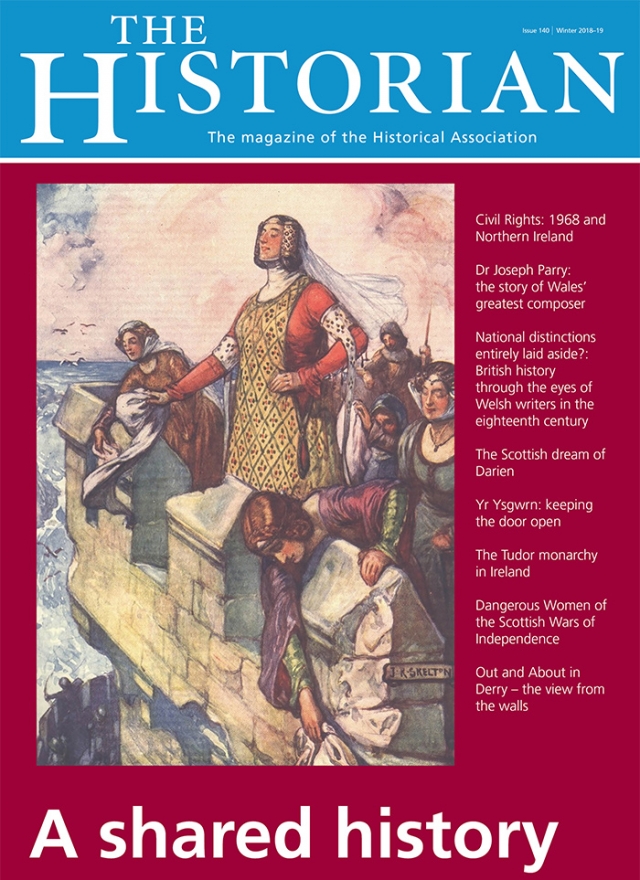The Historian 140: Out now
Journal news

A Shared History
It sometimes seems to those of us living in Scotland, Ireland and Wales that our histories have no importance to anyone beyond our borders and when Americans, and others around the world, say ‘England’ when they actually mean the ‘United Kingdom’, it is hard not to bristle. Contributors to this edition have written about aspects of Scottish, Irish and Welsh history that have relevance throughout the United Kingdom and may also add a little to our knowledge and understanding of each other.
Over the centuries, relations between England, their larger, wealthier and more powerful neighbour, and Scotland, Ireland and Wales have frequently been turbulent. John McBride illustrates this in his feature on the Northern Irish Civil Rights movement of the 1960s, the antecedents of which can be seen in Tudor Ireland, as explained by Sean Connolly. War between Scotland and England in the late thirteenth and early fourteenth centuries was the background to the lives of Kate Ash-Irisarri’s ‘Dangerous Women’ and even the political Union of 1707 was brought about more by the financial disaster described by John McKendrick, than joyful embrace.
The conflicts cannot be denied. Their outcomes have had lasting effects. But, on the other hand, all four countries have benefitted from shared cultural, political and industrial development brought about by influential and important men and women from all parts of the Union and from Ireland. One of those must be Joseph Parry, whose remarkable life is described by Colin James and is clearly a figure who deserves far wider recognition.
Perhaps most importantly, ordinary people have crossed borders, worked, inter-married, settled and had families. In the twentieth-first century we have a co-operative and peaceful modus vivendi. It would be tragic even to consider unravelling it, but, alongside our shared democratic and cultural values, there must be mutual recognition of each nation’s individual identity and pride in their achievements. Interestingly, this seems to be what Lewis Morris was saying in the eighteenth century, as Bethan Jenkins shows in her feature on Welsh writers.
In the quiz game ‘Pointless’ contestants are given a metaphorical red card if they suggest they may not know an answer to a question, for example on the 1970s, because they ‘weren’t born then’. In the same way, it can be no excuse to claim the history of an area is of no interest because one doesn’t live there. Thank you to all the writers who have contributed to this edition. Their articles are certainly of interest to all – they tell part of our shared history.
Off my hobby horse now, I hope many of you are already booking your places for the Historical Association Conference, to be held in Chester, 17 and 18 May 2019. The Early Bird offer closes in March.
Maggie Wilson
Historical fiction and historical fact
In Robert Surtees’ The Jaunts and Jollities of Mr Jorrocks (1843) the eponymous hero is depicted in a variety of settings as he enjoys his leisure pursuit of following the Surrey Hunt. His horsemanship takes him from central London into Surrey and as far as Sevenoaks and Tonbridge in Kent. What is remarkable about the first few chapters is the accuracy of the description of the setting, including the correct name for the proprietor of the Derby Arms hunting stables at Croydon and precise description of the location of the Red Lion at Smitham Bottom. This is not a recommendation to read this book, although apparently this local grocer was the inspiration for Charles Dickens’ Samuel Pickwick, but it does reiterate a point made to me 50 years ago by Professor Alan Everitt: many novels have their storyline set in very well chosen and accurately described contemporaneous settings. In other words they are potential sources for historians.
Historians do work hard to confirm and verify facts. A recent visit to Chester, as part of the preparation for our Annual Conference, led me into St John the Baptist Church. While I was there the vicar asserted that his church ‘used to be the cathedral when the episcopal seat moved from Lichfield’. This seemed the stuff of legend. However when I checked, of course, I discovered that the present-day cathedral was still a monastic house when the Bishop moved his seat to Chester in 1075. From that year until 1095 St John the Baptist Church was indeed the cathedral, prior to the Bishop moving his throne to Coventry. This proves that all similar stories are worth checking.
Accurate settings are frequently provided and seemingly ‘tall stories’ can be verified by careful checking. This leads me to express my concern about the new film about Mary Queen of Scots and Queen Elizabeth and the claim that they actually met. Many scholars over many years have scoured sources to explore and assess the nature of their relationship but they have all concluded that they never met: someone even calculated that they may have been with 15 miles of each other on one occasion but that they did not meet. My view is that the story of these two women is extraordinary enough without resorting to what in modern times we might label ‘fake news’.
On your behalf I wish to thank Maggie Wilson for her editorship of this splendid edition of The Historian.
Trevor James

